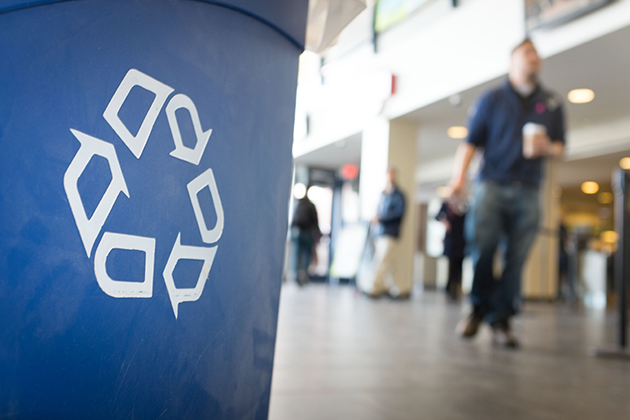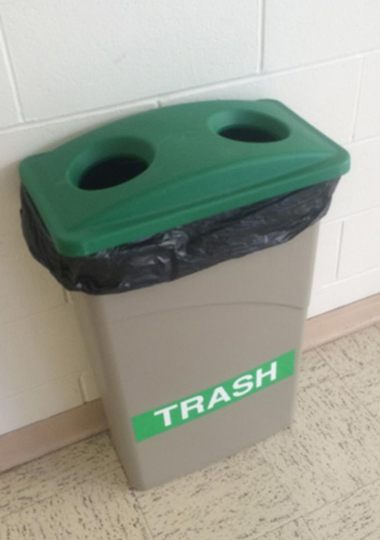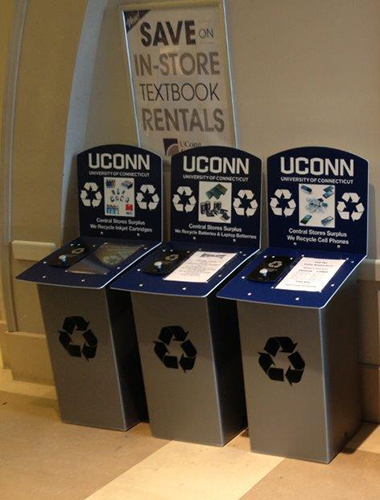Sustainable UConn: How our values about the environment, clean energy, and social responsibility are greening the Husky Blue.
Despite so much good news to report on this Sustainable UConn journey to “Green the Husky Blue,” occasionally we hit a bump in the road.

The results are now in for UConn’s recycling efforts at the main campus in 2013, and they’re not encouraging. For single-stream recycling – commingled paper, plastic, cardboard, bottles, and cans – both the ratio of recycling compared to trash, and the total volume of recyclables collected last year, were at three-year lows.
In 2013, our rate of a mere 18 percent for single-stream recycling – measured by the weight of commingled recyclables collected as a percentage of the weight of trash collected from both indoor and outdoor bins – was at its lowest since UConn introduced single-stream recycling in 2009. And this rate plummeted even lower during the summer months last year – below 10 percent – less than half the rate of previous summers. What’s goin’ on (or not)?

Considering the relatively high environmental IQ of UConn students, most of whom are from home towns where curbside recycling is mandatory, this trend seems all wrong. And given that undergraduate students participating in Office of Environmental Policy’s latest Environmental Awareness Survey ranked recycling as the top environmental issue on campus, why is our single-stream rate so low?
One factor has to do with the bins. The EcoHusky student group recently conducted a recycling bin audit in select campus buildings and found a few problems:
- The lack-of-convenience factor: recycling and trash bins were frequently not coupled in classrooms and hallways, as they were originally meant to be.
- Areas with only a recycling or a trash bin had significant commingling of recycling and trash; restrictive lids were sometimes removed or labels were covered. Once recyclables have been commingled with trash, the entire container will most likely end up as trash.
- More outdoor recycling bins are needed near the residence halls – outdoor trash bins in these areas were filled with recyclables.
- Many are confused by the dual-stream recycling lids on the bins purchased in 2007, which have been used for single-stream recycling since 2010.
In addition, the recent Environmental Awareness Survey showed that most students are not aware of UConn’s single-stream recycling program.

There is a silver lining to this dark cloud, however. Kudos to the UConn Central Warehouse and Surplus Store staff, who have stepped up their efforts and found a resourceful and reliable way to measure waste diversion of surplus items through reuse of things like old office equipment and furniture. Reuse through the Surplus Store amounted to an impressive 230 tons diverted from Connecticut’s trash-to-energy incinerators last year. (Note: only a very small percentage of UConn’s trash ever goes to landfills, which are scarce in this part of the country.) Central Warehouse staff also helped upgrade our personal e-waste recycling program, splitting the cost of new containers with UConn’s Campus Sustainability Fund, and managing the e-waste collection and recycling process. E-waste includes cell phones, batteries/laptop batteries, and inkjet cartridges.
Dining Services also added two more in-kitchen, eCorect decomposition machines, bringing the total number to five; these are located in Whitney, Buckley, South, Gelfenbein, and Putnam dining halls. Using just 3 kwh of energy over a 12- to 18-hour cycle, they reduce pre- and post-consumer food waste volume by 80 percent and create a compost-like material that can be used by Landscaping Services.
Together, these kinds of positive changes offset the reductions in single-stream recycling and our end-of-year move out program, Give & Go, and helped keep UConn’s overall diversion rate, which accounts for multiple waste streams, about the same as recent years, at around 35 percent. Still, that’s not the kind of diversion rate UConn wants to have as the reigning #1 ranked Sierra Club Cool School in the U.S. A few of our peer institutions are 10, 20, or 30 percent higher, and interns in the Office of Environmental Policy are busily researching their programs to figure out what they’re doing differently to create a culture of recycling.
So let’s call 2014 a “rebuilding year” for recycling at UConn. Please send your ideas for changing the culture and raising the bar at UConn to envpolicy@uconn.edu.



